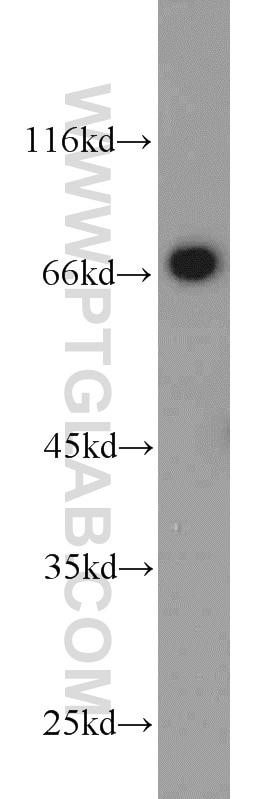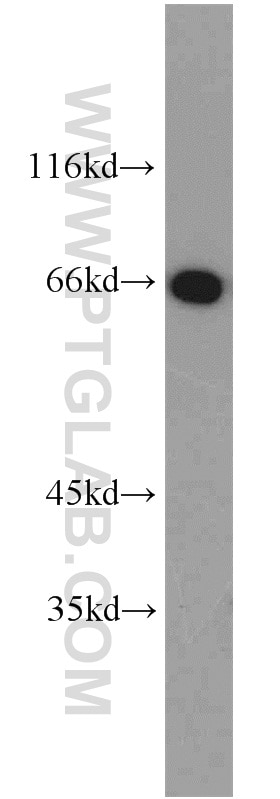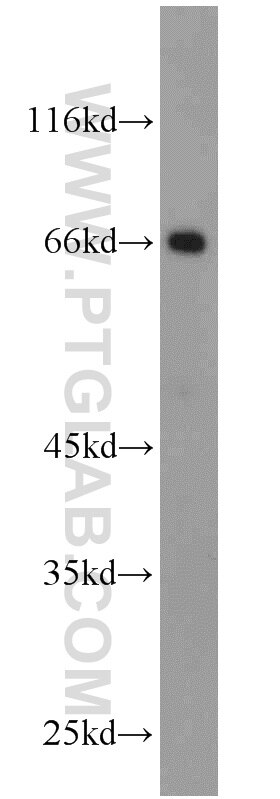Tested Applications
| Positive WB detected in | HeLa cells, human brain tissue, mouse brain tissue, mouse lung tissue, rat brain tissue, mouse heart tissue, mouse skeletal muscle tissue |
| Positive IHC detected in | mouse brain tissue Note: suggested antigen retrieval with TE buffer pH 9.0; (*) Alternatively, antigen retrieval may be performed with citrate buffer pH 6.0 |
Recommended dilution
| Application | Dilution |
|---|---|
| Western Blot (WB) | WB : 1:1000-1:4000 |
| Immunohistochemistry (IHC) | IHC : 1:50-1:500 |
| It is recommended that this reagent should be titrated in each testing system to obtain optimal results. | |
| Sample-dependent, Check data in validation data gallery. | |
Published Applications
| WB | See 1 publications below |
Product Information
22883-1-AP targets HSF4 in WB, IHC, ELISA applications and shows reactivity with human, mouse, rat samples.
| Tested Reactivity | human, mouse, rat |
| Cited Reactivity | human |
| Host / Isotype | Rabbit / IgG |
| Class | Polyclonal |
| Type | Antibody |
| Immunogen |
CatNo: Ag18935 Product name: Recombinant human HSF4 protein Source: e coli.-derived, PGEX-4T Tag: GST Domain: 340-462 aa of BC153061 Sequence: DRSPESLLPPMLLQPPQESVEPAGPLDVLGPSLQGREWTLMDLDMELSLMQPLVPERGEPELAVKGLNSPSPGKDPTLGAPLLLDVQAALGGPALGLPGALTIYSTPESRTASYLGPEASPSP Predict reactive species |
| Full Name | heat shock transcription factor 4 |
| Calculated Molecular Weight | 492 aa, 53 kDa |
| Observed Molecular Weight | 62-66 kDa |
| GenBank Accession Number | BC153061 |
| Gene Symbol | HSF4 |
| Gene ID (NCBI) | 3299 |
| RRID | AB_2879184 |
| Conjugate | Unconjugated |
| Form | Liquid |
| Purification Method | Antigen Affinity purified |
| UNIPROT ID | Q9ULV5 |
| Storage Buffer | PBS with 0.02% sodium azide and 50% glycerol, pH 7.3. |
| Storage Conditions | Store at -20°C. Stable for one year after shipment. Aliquoting is unnecessary for -20oC storage. 20ul sizes contain 0.1% BSA. |
Background Information
Prokaryotic and eukaryotic cells respond to thermal and chemical stress by inducing a group of genes collectively designated heat shock genes. In eukaryotes, this gene expression is regulated primarily at the transcriptionlevel. Heat shock transcription factors (HSF, also designated HSTF) 1 and 2 are involved in this regulation. HSF1 and HSF2 are upregulated by estrogen, at both the mRNA and protein level. HSF1 is normally found as a monomer, whose transcriptional activity is repressed by constitutive phosphorylation. Upon activation, HSF1 forms trimers, gains DNA binding activity and is translocated to the nucleus. HSF2 activity is associated with differentiation and development, and, like HSF1, binds DNA as a trimer. HSF4 exists as two splice variants and is expressed in heart, brain and skeletal muscle as a homotrimer. HSF4a does not contain a DNA-binding domain and inhibits the formation of HSF1 nuclear bodies, thus repressing HSF1 mediated transcription. HSF4b does contain a DNA-binding domain and colocalizes with HSF1 nuclear bodies after heat shock. This antibody is specific to human HSF4.
Protocols
| Product Specific Protocols | |
|---|---|
| IHC protocol for HSF4 antibody 22883-1-AP | Download protocol |
| WB protocol for HSF4 antibody 22883-1-AP | Download protocol |
| Standard Protocols | |
|---|---|
| Click here to view our Standard Protocols |


















